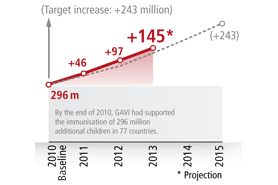GAVI Alliance on track to immunise a quarter of a billion children by 2015 and prevent nearly 4 million deaths

The newly released Mid-Term Review report predicts that GAVI is on track to support developing countries to immunise almost a quarter of a billion additional children by 2015.
Geneva, 14 October 2013 - The GAVI Alliance is on track to meet its ambitious targets of supporting developing countries to immunise an additional quarter of a billion children by 2015, and preventing nearly four million deaths in the process.
That’s the conclusion of the Mid-Term Review report, a comprehensive and transparent assessment published today aimed at examining the progress GAVI has made midway through its current strategic period from 2011 to 2015, and the challenges it faces in meeting its commitments to developing countries and to donors.
Closing the gap
“GAVI is reaching record numbers of children with life-saving vaccines, just over two years after our successful pledging conference and midway through our current strategy period,” said Dagfinn Høybråten, Chair of the GAVI Alliance Board. “More countries than ever are introducing new vaccines, resulting in more deaths averted and improved health and wellbeing for millions of people.”
In addition to reaching its goal of helping developing countries immunise 243 million children between 2011 and 2015, GAVI is also on target to help avert nearly four million future deaths during the same period. The report also found that the historic gap in access to immunisation between low- and high-income countries is starting to close. In the Kilifi district of Kenya, for example, the number of hospital admissions of children with pneumococcal disease from vaccine serotypes fell from 38 to zero within less than three years of the introduction of pneumococcal vaccine.
Impact stories
Such accounts have been captured in a series of impact stories that are being published on the GAVI website alongside the report. These show the extraordinary efforts of implementing countries and Alliance members to ensure vaccines reach the children who need them, wherever they live.
Together, the report and the impact stories come mid-way through GAVI’s funding cycle, following its first ever pledging conference in London, in 2011, where GAVI raised additional funding to enable it to commit a total of US$ 7.4 billion towards its mission.
Mid-Term Review
The report is being published two weeks before GAVI partners – including the World Health Organization, UNICEF, the World Bank, the Bill & Melinda Gates Foundation, implementing and donor countries, civil society organisations and vaccine manufacturers – meet in Stockholm for the Alliance’s Mid-Term Review.
Hosted by Hillevi Engström, Sweden’s Minister for International Development Cooperation and HE John Dramani Mahama, President of Ghana, more than 150 participants will discuss GAVI’s progress and challenges, as laid out in this report, which also shows that GAVI has made significant strides towards achieving its four strategic goals.
These goals include: accelerating the uptake and use of under-used and new vaccines; strengthening health systems to improve immunisation coverage; improving long-term predictability and stability of immunisation financing; and helping to improve vaccine market conditions for developing countries. According to the report, progress has been made in the following areas:
- Since 2011, GAVI has funded a total of 67 new vaccine introductions and campaigns. By 2014 all 73 GAVI-supported countries will have introduced 5-in-1 pentavalent vaccines, including introductions in Haiti, Myanmar, Somalia and South Sudan.
- Following a slow start, GAVI’s recently revamped health system strengthening programme now ensures that investments are translated more clearly into improved immunisation outcomes. As a result, GAVI is seeing investments and improvements in health system rapidly picking up speed.
- GAVI is close to achieving its target of timely receipt of 100% of co-financing payments (contributions made by developing countries towards the cost of the vaccines). As of August, 64 of the 67 co-financing countries had fulfilled their commitments for 2012. And from 2011 to 2013 these payments totalled US$ 125 million, representing 8% of GAVI’s total support to these countries. All this is also helping to drive increases in country investment in their own health systems.
- GAVI has also helped to produce more predictability and competition in the vaccine market, which has helped to bring down the cost of fully vaccinating a child with three priority vaccines – pentavalent, pneumococcal and rotavirus - from US$ 35 in 2010 to US$ 23 in 2012.
Healthier futures
The report also highlights the challenges that the Alliance is attempting to address. These include improving the reliability of supply chains and finding ways to improve in-country data collection; adopting tailored approaches to meet the unique and challenging needs of fragile states; and ensuring the sustainability of immunisation programmes in countries whose wealth has increased to the point that they are no longer eligible for GAVI support.
“Increasing vaccine launches is just the start of the journey. As more countries introduce powerful new vaccines the challenge shifts to increasing and sustaining immunisation coverage and making it more equitable,” said Dr Seth Berkley, CEO of the GAVI Alliance.
“Vaccines are already widely recognised as one of the most-cost effective public health tools, but we cannot rest until all children, regardless of where they live, have access to the best possible protection against vaccine-preventable diseases. That means access to all 11 of the vaccines that the WHO recommends every child should have. Every child deserves a healthy future.”
GAVI is funded by governments [Australia, Canada, Denmark, France, Germany, Ireland, Italy, Japan, Luxembourg, Netherlands, Norway, Republic of Korea, Russia, South Africa, Spain, Sweden, United Kingdom, United States], the European Commission, the Bill & Melinda Gates Foundation, as well as private and corporate partners [Absolute Return for Kids, Anglo American plc., The Children’s Investment Fund Foundation, Comic Relief, Dutch Postcode Lottery, His Highness Sheikh Bin Zayed Al Nahyan, JP Morgan, “la Caixa” Foundation, LDS Charities and Vodafone].
Click to view the full donor list.
